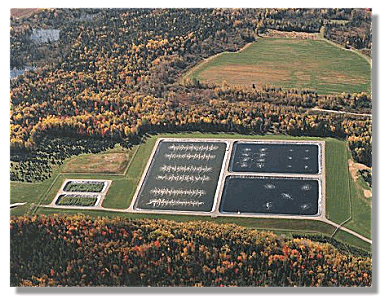Fort Kent
Water and
Wastewater Department

The majority of the
wastewater collection, pumping and treatment facilities within the
Town of Fort Kent were originally constructed in the late
1960's, and within the flood plain of the St. John and Fish
Rivers. Portions of the sewer system were periodically subject to the
effects of high groundwater and spring runoff or rainfall. An upgrade
of the facility in 1988 substantially improved treatment but did not
address all of the issues.
The Fort
Kent Utility District retained an engineering firm to evaluate
various alternatives and to prepare the design for the rehabilitation
of the existing wastewater collection and pumping systems and new
wastewater treatment facility.
The first phase of
the project was to separate the sewer and stormwater systems within
the Riverside Park area. This was performed in order to reduce the
volume of groundwater and stormwater (infiltration and inflow)
entering the collection system and to eliminate untreated overflows to
the Fish River.
The second phase
involved the upgrade of six existing wastewater pumping stations to
reduce the number of wastewater bypasses to the two rivers. This
included new pumps, controls, emergency standby power provisions and a
radio telemetry alarm system. This phase also included the replacement
of force mains on two pump stations and the installation of tide
valves on the pump station overflows, effectively eliminating the risk
of flood waters entering the pump station.
Phase three
consisted of a new main pump station; an 11,100 linear foot 12-inch
diameter force main; a three cell aerated facultative lagoon treatment
system; sludge drying beds; disinfection facilities; an operations
building; a monitoring station located at Northland Frozen Foods; and
a 5,900 linear foot 12- inch diameter outfall pipe to the St. John
River. The main pump station was also provided with preliminary
treatment facilities consisting of a mechanical bar screen and a grit
removal system.
The new
wastewater treatment facility is designed to treat an average daily
flow of 0.43 mgd with peak flows of 1.1 mgd. The three cell aerated
facultative lagoons have a total capacity of 36 million gallons.
Aeration is provided to the lagoons via four blowers, an air
distribution piping system and 87 fine bubble tubular membrane
diffuser assemblies. From the lagoons, treated wastewater flows to the
chlorine contact tank where, on a seasonal basis, sodium hypochlorite
is added to disinfect the effluent. The disinfected wastewater flows
through the new gravity outfall pipe to the St. John River.

The upgrade of the wastewater treatment facilities was needed
in order to meet state and federal discharge requirements and most
importantly, to protect the St. John and Fish Rivers from
contamination. The facility monitors the total wasteload from the food
processing facility. This information is instantaneously transmitted
back to the operations building via the radio telemetry system.
The final phase
of the upgrade consisted of replacing and repairing sewers and service
lines, and rehabilitating manholes throughout the District's
collection system. This phase has significantly reduced the volume of
infiltration and inflow within the sewer system while addressing the
structurally deficient areas.
The total
cost of all of the wastewater treatment facilities improvements
including construction, land acquisition, administration and technical
services was approximately $8.5 million. Approximately 75% of the
project was funded by state and federal grants through the Department
of Environmental Protection, Rural Economic and Community Development
(RECD), the Department of Economic and Community Development, as well
as Northland Frozen Foods. Long-term financing of the District's share
of the project cost has been provided in the form of a loan from RECD.
Lagoon Specifications
|
Lagoons |
No.1 |
No.2 |
No. 3 |
|
Volume |
18 MG |
9.0 MG |
9.0 MG |
|
Lagoon Dimensions |
560' x 340' x 18' |
408' x 265' x 17' |
408' x 265' x 17' |
|
Lagoon Acreage |
4.37 acres |
2.48 acres |
2.48 acres |
|
Aeration |
Fine
Bubble |
Fine
Bubble |
Fine
Bubble |
|
Number of Aerators |
68 |
14 |
5 |
Comments:
Total lagoon acreage is 9.3 or 406,414 square feet. Facility has
(4) 30 horsepower Roots blowers, 2 of which are on VFD's. Aeration
System manufacturer is Environmental Dynamics, Inc. and diffuser
model is the FlexAir. |
System Information
|
Design Flow |
0.43 MGD |
|
Actual Flow |
0.30 MGD |
|
Discharge To |
St. John
River |
|
Year Built |
1997 |
|
Design Engineers |
Wright-Pierce |
|
Septage Received |
No |
|
Collector System |
16 miles
of gravity, 250 manholes , 7 pump stations |
|
Staff Size |
4.5 Full
Time |
|
Number of Users |
1,270
Services |
|
Billing Software |
Gemini |
|
Comments |
Plant
has reedbeds (2) for sludge treatment. The beds are 150' x 45' in
size. |
Back to Lagoons in
Maine

